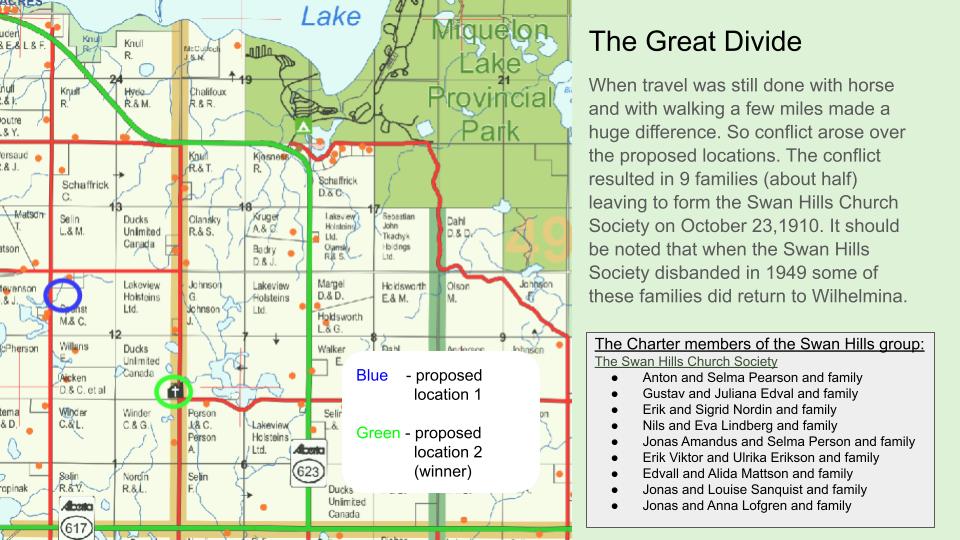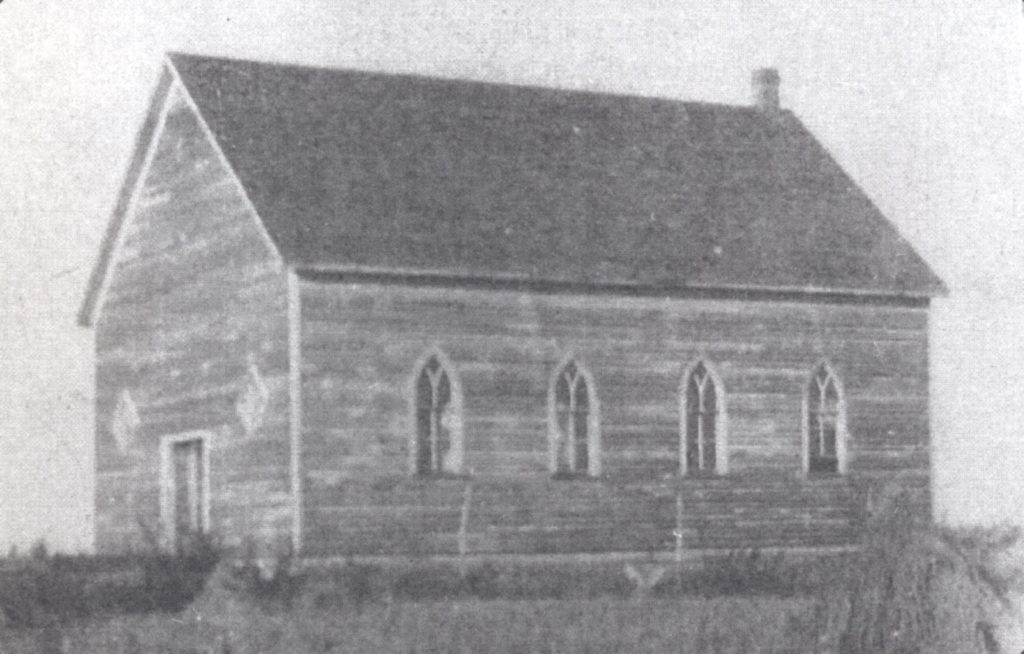The Swan Hills Church Society history is significant because this was the group from Wilhelmina Lutheran who decided to leave the congregation in 1910 rather than accept the location chosen for the new building site.
History of the Swan Hills Church Society
The following information has been printed from the St. Joseph Lutheran Congregation: 100 Years of Grace Centennial Anniversary Program August 26, 2007 compiled by Alan Welde and published by A.S.A.P. Desktop Publishers Round Hill. Excerpts from pages 16-17, 22-23.
The early 1900’s also saw the movement of Swedish families into the east Hay Lakes area. In 1900 Jacob and Inga Lunde homesteaded about seven miles east of Hay Lakes, and the hills, stands of bush and the bodies of water reminded Inga of her home in Granliden in Vilhelmina, Sweden (Each Step, p.554), prompting Inga to write letters of encouragement to relatives and acquaintances to immigrate to the area. In 1902 Inga’s brother Magnus Janson homesteaded. In 1903 brothers Axel Krisoffer Selin and Petter Amandus Selin and familes arrived to claim land (In-och Utflytttningsbok, p.3); these settlers in turn encouraged other families to come to the district. Many of these Swedish immigrants settled slightly south and east of where the St. Joseph Norwegians had homesteaded. Since fourteen of these families were from Vilhelmina parish of Vasterbotten province in Northern Sweden, the area where they settled was called “Hilsa”, “Little Sweden” or often “Vilhelmina”. The chain of Amerika-bre (“America-letters”) conincided with an increase in emigration from Vilhelmina in the years 1903 to 1912 precipitated by economic hardhips, an expanding population, a subsistence form of agriculture, and the lure of improved conditions in North America.
The Swedish settlers who wished to attend church services had to travel approximately ten miles southeast to Fridhem Lutheran Church of the Augustana Synod. Fridhem Lutheran Church had been organized in 1902 and was served by Pastor Olof Lindgren. On November 7, 1908, an organizational meeting of “The Swedish Evangelical Lutheran Wilhelmina Congregation” was held with Pastor Lindgren as the congregation’s pastor (“Wilhelmina Lutheran Church”).

The selection of a building site for the Wilhelmina Lutheran Church caused considerable dissension among the congregation’s eighteen families. Two sites for construction were plots from SW 12-14-49 W4 and SE 12-49-21 W4; when the offer to donate land for a church and cemetery on SW 12-49-21 was withdrawn, the committee responsible for site selection decided that another site on SE 12-49-21 was best. The decision to build on this new site was ratified by a majority of two votes at a congregation meeting held September 9, 1909. Congregation members from the western end of the community felt the etra mile to travel to church was a considerable inconvenience given the lack of roads and the distance some families already had to travel, while members from the eastern side of the community felt the site was topographically suited for a church and graveyard. Pastor Lindgren preferred the location of SE 21-49-21, and Inga Lunde promised a substantial gift ($300.00) toward construction expenses if the church was located on that site.
On October 23, 1910, nine families separated from the Wilhelmina congregation to form their own congregation, the Swan Hill Church Society. “Swan Hill” was selected as the name of the congregation as many of the members lived within the boundaries of Swan Hill School District No. 1665. Charter members of the Christian Church Society were Anton and Selma Pearson, Gustav and Juliana Edval, P.Erik and Sigrid Nordin, Nils and Eva Lindberg, Jonas Amandus and Selma Person, Erick Viktor and Ulrika Erikson, Edvall and Alida Mattson, Jonas and Louise Sandquist, and Jonas and Anna Lofgren and families (Secreterens boch, p.6). The Society purchased 1.5 acres of land of NE 10-49-10 W4 to use as its own cemetery. The intent of the Society was to hold Lutheran services in members’ homes until enough money had been raised to construct its own church building, and that the newly organized congregation share the pastor that Wilhelmina used. Pastor Lindgren declined to hold services for those who had broken away from Wilhelmina Congregation and the Augustana Synod. Lutheran pastors from Wetaskiwin provided services until Pastor Leonard Heiner served both Wilhelmina and the Church Society from 1915 until 1918.
Minutes from a January 25, 1915 meeting at the Lars Grue home “regarding the possibility of the Norwegian congregation of St. Joseph and the Swedish congregation at Swanhill working together” record a motion that “the two congregations together build a church” (Scandinavian Church Records Book, January 25, 1915). The church was to be 30 feet by 40 feet in dimension, and was to be built midway between the St. Joseph cemetery and the Swan Hill cemetery on one half acre of NW 15-49-21 W4 purchased from Eric Nordin and one-half acre of SW 15-49-21 W4 purchased from Johan Lofgren. The issue of joint church construction was discussed at the January 28, 1915 meeting of the Swan Hill church society: “The decision which was made to build a church together with the Norwegians on NW15-49-21 W4 which was accepted unanimously” (Secreterens Boch, p.9). The two groups agreed on July 3, 1915 that the church would hold to God’s Word as given in the Old and New Testament holy writings, but each group would operate independently and retain its separate graveyard (“Disse statuter”, 1,2,3). The congregation also agreed to an annual meeting in January of each year to deal with any custodial concerns and issues relating to the Scandinavia Church. Leadership was to be provided by a committee of four persons (two drawn from each congregation) with two-year terms and a fifth member to function as a spokesperson to the St. Joseph and Swan Hill Congregations. (“Disse statuter”, 6,9). A committee of Nels Lindberg, Anton Person, Ole Sware and Lars Grue was given the responsibility of working out the necessary arrangements and construction details. At a February 16, 1915 meeting at Sulitjelma School, it was agreed that the church lot be purchased for $15.00, with the St. Joseph congregation owning one-half acre and the Swan Hill Church Society owning one-half acre. Charles Holmberg was hired as head carpenter for the building project. On June 5, 1915, Charles Holmberg’s contract offer to build the church for $360.00 was accepted. The church was to be ready for November 1, 1915 (Scandinavian Church Records Book).

The completed church was called the “Scandinavia Church”. Each congregation contributed toward the construction and maintenance of the church building, but the congregations hired their separate pastors, held their own monthly services, and were responsible for the care of their own cemeteries. The Swan Hill Church Society services were held in Swedish and were conducted by Lutheran or Mission Covenant pastors from Wetaskiwin. The Saint Joseph Services were held in Norwegian on the fourth Sunday of the month, weather permitting.
…
As early as 1926, the Swan Hill Church Society and the Saint Joseph congregation expressed an interest in dissolving their joint ownership of the Scandinavian Church. In March of 1926 the Swan Hill Church Society offered to purchase the Saint Joseph share of the building for $350.00, but the offer was refused. The offer to purchase the Saint Joseph share was again refused in 1928, but the Swan Hill Church Society decided it would sell its share in the building if the Saint Joseph congregation would offer $500.00. Membership in the Swan Hill Church Society had not increased as much as had the membership of the Saint Joseph congregation; it was becoming more difficult for the Swan Hill Church Society to meet its financial obligations to the Scandinavian Church and provide for its own pastor. The Swan Hill Church Society had become increasingly affiliated with the Mission Covenant Church during the late 1930’s and 1940’s. The two groups also had different views on how the church building should be used: the Haugeans of the Saint Joseph congregation didn’t feel that social activities such as card [whist] parties should be held in the church, while the Christian Society felt the building served both social and religious functions in the community. The Sulitjelma School building on NW 22-49-21 W4 was used as occasion demanded for social gatherings by the St. Joseph congregation. As well, the Swan Hill Church Society was seen as ‘Swedish’ by its founders and the Saint Joseph congregation was seen as ‘Norwegian’ and Lutheran by its founders. Each group wanted to keep its own ethnic identity, and this was made difficult when sharing the church building.
…
The Swan Hill Church Society became less active during the 1940’s as its membership continued to decline. At a meeting held September 15, 1946, the Society suggested that $500.00 or $600.00 should be the value placed on its share of the building. In 1947 the church building was valued at $1200.00. Charles Holmberg and Anton Pearson were given the responsibility of presenting the offer to the Saint Joseph congregation. In 1948 the Saint Joseph Congregation moved to “offer the Swedish partners $400.00 for their share in the church, and if it is not accepted, to see if we could arrange to dismantle the church.” A month later it was decided “we accept the Swan Hill Church Society offer to sell its interest for $500.00 and buy their share for $500.00” (St. Joseph Records Book). The Saint Joseph ‘church committee’ of Simen Grue and Hans Sware were to arrange to get the title of the church property prior to the official transaction. On January 31, 1949 the Swedish share in the Scandinavian Church building was purchased for $500.00 by the Saint Joseph congregation. The Swan Hill Church Society disbanded shortly after sellling its share of the building, with some members joining Wilhelmina Lutheran Congregation, Bethel Lutheran Congregation in Camrose, or Our Saviour Lutheran Congregation in Hay Lakes.
History Book Pages
*****
The Swan Hills Church Society
Organized:
October 23, 1910
Disbanded:
1949
The Swan Hills Church Society was a breakaway group from Wilhelmina Lutheran who were unhappy with the location chosen for the new building site.
In 1915 an agreement was made with the Norwegian St. Joseph congregation to construct and maintain a church building to be jointly shared by the two congregations. It would be located approximately half way between the two church cemeteries.
This agreement remained in effect until the group disbanded in 1949.
Some members then chose to return to Wilhelmina Lutheran Church as members.
